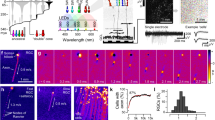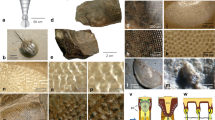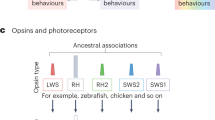Abstract
LIKE moths, the eyes of many pelagic and bottom-living decapods appear to glow brightly when viewed from the direction of illumination1. It has generally been assumed that the optical system involved is similar to that in nocturnal insects, that is, the superposition mechanism of Exner2. The essential feature of Exner's theory is that the optical apparatus of the cornea and crystalline cone refracts light through twice the angle at which it was incident on the cornea (Fig. 1a). Light from many facets then combines to form a single image on the receptor layer, and if this is backed by a tapetum the light is reflected out through the same facets that it entered, causing the glow. There is now no doubt that Exner's mechanism is present in some insects3. Recent accounts have, however, cast doubt on whether it occurs in Crustacea4,5. This is largely because the high refractive indices and inhomogeneities required of the optical components have been shown not to be present. In this paper I show that superposition images are formed in the eyes of a midwater shrimp, but in a different. manner (Fig. 1b).
This is a preview of subscription content, access via your institution
Access options
Subscribe to this journal
Receive 51 print issues and online access
$199.00 per year
only $3.90 per issue
Buy this article
- Purchase on Springer Link
- Instant access to full article PDF
Prices may be subject to local taxes which are calculated during checkout
Similar content being viewed by others
References
Loew, E. R., Proc. R. Soc., B 193, 31 (1976).
Exner, S., Die Physiologic der facettirten Augen von Krebsen und Insekten (Deuticke Leipzig and Wien, 1891).
Horridge, G. A., The Compound Eye and Vision of Insects (edit. by Horridge, G. A.), 255 (Clarendon, Oxford, 1975).
Waterman, T. H., The Physiology of Crustacea, II (edit. by Waterman, T. H.), 1 (Academic, New York and London, 1961).
Carricaburu, P., The Compound Eye and Vision of Insects (edit. by Horridge, G. A.), 236 (Clarendon, Oxford, 1975).
Höglund, G., The Functional Organization of the Compound Eye (edit. by Bernhard, C. G.), 77 (Pergamon, Oxford, 1966).
Land, M. F., Prog. Biophys. molec. Biol, 24, 75 (1972).
Vogt, K., Z. Naturforsch., 30 c 691 (1975).
Kunze, P., Z. vergl. Physiol., 76, 347 (1972).
Author information
Authors and Affiliations
Rights and permissions
About this article
Cite this article
LAND, M. Superposition images are formed by reflection in the eyes of some oceanic decapod Crustacea. Nature 263, 764–765 (1976). https://doi.org/10.1038/263764a0
Received:
Accepted:
Issue Date:
DOI: https://doi.org/10.1038/263764a0
This article is cited by
-
Traces of an ancient immune system – how an injured arthropod survived 465 million years ago
Scientific Reports (2017)
-
Artificial compound eye: a survey of the state-of-the-art
Artificial Intelligence Review (2017)
-
Vision in the dimmest habitats on Earth
Journal of Comparative Physiology A (2004)
Comments
By submitting a comment you agree to abide by our Terms and Community Guidelines. If you find something abusive or that does not comply with our terms or guidelines please flag it as inappropriate.



